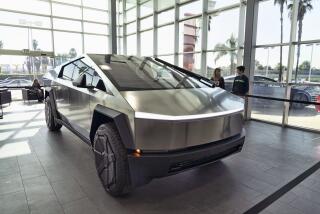Toyota acknowledges software bug in ‘black box’ reader
Toyota Motor Corp. has acknowledged that a software bug in the device used to read its black boxes produced faulty data, only months after the automaker touted information from the recorders to suggest that human error caused sudden acceleration.
The automaker said it spotted and fixed the problem — which could give incorrect information on speed — in June and that it did not affect readings for pedal and brake application, crucial keys to determining potential causes of sudden acceleration.
But the admission casts fresh doubt on the reliability of data taken from black boxes, known as event data recorders, or EDRs, even as they have been used to help prop up the company’s image as it weathers its ongoing recall crisis. Toyota has issued more than 11 million recall notices in the last year and has been hit with hundreds of lawsuits.
“You can’t rely on event data recorders to determine whether there has been a sudden acceleration event,” said Clarence Ditlow, executive director of the Center for Auto Safety. “We can’t take Toyota at face value that the EDR is accurate enough to clear them of responsibility for sudden unintended acceleration.”
Toyota for years argued in courtrooms that black box data were not reliable and that the proprietary reader used to interpret them was a prototype. It was not until the automaker faced thousands of allegations that its vehicles accelerated without being told to that it began holding up EDR downloads as evidence that drivers, rather than vehicles, were at fault.
Toyota spokesman Mike Michels said that the software bug, which involved how information about post-crash change in velocity was interpreted, did not affect readouts for any other data points, particularly for those collected prior to impact, called pre-crash data.
“Going forward, we do have confidence in the reader,” said Michels, adding that the company no longer considered it a prototype and that there were no known problems with the EDR itself. “This information is potentially valuable for determining causes of accidents.”
Last month, the National Highway Traffic Safety Administration reported to Congress that it had reviewed 58 EDRs from Toyota vehicles involved in accidents and that they did not indicate any new safety defects.
Instead, the safety regulator found that 35 of the 58 recorders showed that the brake had not been applied, suggesting that driver error, rather than a vehicle defect, caused the crashes.
But it is not clear how many of those EDRs were interpreted by readers that still had the software defect. NHTSA began its readouts in mid-March, after Toyota supplied it with 10 of its readers, according to a presentation given by the Transportation Department to Congress.
In early April, Toyota downloaded data from an EDR in a crashed 2007 Tundra using the uncorrected software, resulting in what the company now says was erroneous data. Specifically, the readout indicated that the pickup slowed by 177 mph upon impact, a speed Toyota now admits is impossible.
It wasn’t until June that a software upgrade was provided to NHTSA, Toyota’s Michels said. He said the company had reread the data from the Tundra and that it now showed a change of velocity of 1.4 mph.
NHTSA said that it independently tested and verified the accuracy of the Toyota readers and that it was confident the data they produced reflected that captured by the onboard recorders. The agency said it has since rerun the EDR data through the updated software.
Ron Eves, father of the Tundra’s driver, who was killed, said he has had no contact with Toyota since the download of the EDR was conducted in April.
“It is a waste of a dime to call them, because they will not respond to what the inaccuracies are in their recorder,” said Eves, who plans to ask the company to reexamine his son’s black box.
Toyota Executive Vice President Takeshi Uchiyamada disclosed the software problem and subsequent fix in a meeting with reporters in Detroit on Monday. The news was first reported by Reuters.
Until this year, Toyota had only one black box reader in the U.S., and did not allow outsiders to use it. The company has since deployed 150 such readers, including devices given to NHTSA and Transport Canada. Toyota plans to release a commercially available version of the reader in the near future. Other automakers, including General Motors Co. and Chrysler, already make such readers available to the public.
ken.bensinger@latimes.com
ralph.vartabedian@latimes.com







